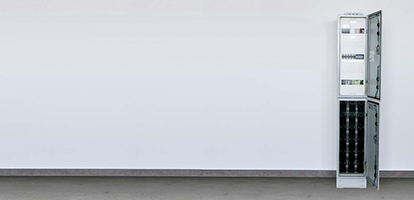
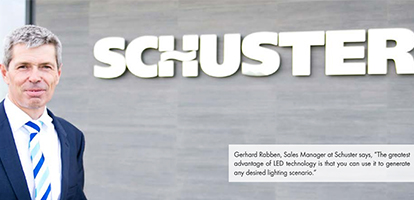
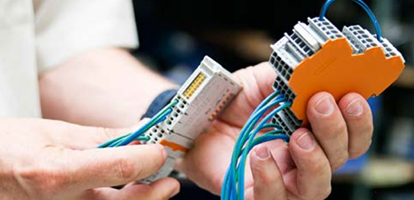
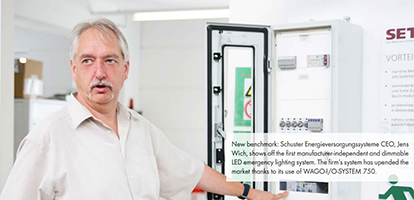
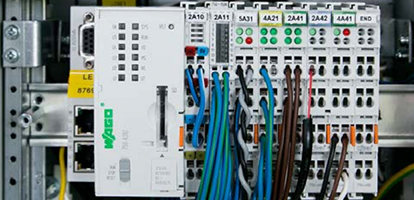

Schuster Energieversorgunssysteme, an energy supply solutions specialist, has generated quite a stir with its innovative, manufacturer-independent system for emergency lighting. Early adopters in the automotive industry lead the way, and now companies from other sectors are showing interest. At the core of the lighting solution is the WAGO-I/O-SYSTEM 750, which implements the intelligent lighting control functions.
When it involves safety lighting systems, no other company is as innovative as Schuster Energieversorgungssysteme GmbH & Co. KG. For four decades, the company in Grevenbroich, Germany has mitigated the effects of power failures by producing sophisticated systems for emergency lighting, transformer rectifiers and power inverters, as well as other solutions. The firm has a legacy of consistently producing innovative ideas backed by the highest quality. This has earned Schuster an excellent reputation backed by excellent customer testimonials. It’s also why the company from Grevenbroich equips the Berlin Olympic Stadium, Apple Stores in Germany and major tradeshows in Frankfurt and Dusseldorf. Recently, Schuster found itself in an enviable role — not only is the company widely regarded as the best in their field, but thanks to recent breakthroughs, they are now also seen as their sector’s leader in technological development. “We made quite an advancement with our systems recently,” explains CEO Jens Wich.
That sounds far too modest. In fact, Schuster has developed a unique system for emergency lighting that is setting several new industry standards, and has already installed it in multiple facilities belonging to an automobile manufacturer. SETLON is one of just a few systems on the market based on modern LED technology. And one of the system’s biggest draws is that it eliminates the distinction between general and safety lighting — it uses the same lights for both. One part also runs in the emergency operating mode. “This is possible because we can generate multiple lighting scenarios with SETLON by dimming individual lights,” shares Wich.
Each Individual LED Can Be Controlled
There is an entire range of laws, ordinances and guidelines regarding emergency operation of lights in buildings. And this shouldn’t surprise anybody — human lives depend on good emergency lighting. As such, emergency lighting should, for example, illuminate routes for rescuers at a specified time and also indicate escape routes. Another specification calls for providing sufficient light to high-risk jobs. Emergency lighting should also prevent panic by countering the feelings of claustrophobia (or being trapped) with extensive illumination. In addition, emergency lighting must work during power outages, for example, emergency lighting is needed in hospitals at all times. And given the specific nature of each scenario, each has been prescribed with a different level of brightness. In traditional systems, these were achieved using fluorescent tubes or incandescent bulbs. It is much easier with modern LED lights. “The biggest advantage of LED technology is that you can use it to generate any desired lighting scenario,” states Gerhard Rabben, Sales Manager at Schuster. In addition, LED technology is much more robust, has a longer service life and consumes less energy.
However, in order to implement different lighting scenarios with LED lights, each diode must be individually addressed. Furthermore, all components in the emergency lighting system must be monitored, as this is the only way to ensure that everything actually functions as intended during a power failure. Which leads to a rather large problem, as Wich explains, “In standard systems, additional components were incorporated into the lights to provide the required control and monitoring for an emergency lighting system.” This procedure is still prevalent in the field — despite significant disadvantages. If lights are modified, they lose their CE marking and thus their operating license. This is why Schuster took an alternative path. Instead of rebuilding the lights, the company from Grevenbroich provided them with intelligent, centralized control. “We use the WAGO-I/O-SYSTEM 750 from WAGO as the control element so we can address the lights using the DALI communication protocol. As a result, we can individually control and check every LED,” states Wich, Schuster’s CEO.
Open Source System Provides Customers with Choices
Using the open-source DALI protocol (Digital Addressable Lighting Interface) has created another advantage: any light available on the market can be used, as long as it communicates using DALI. However, this approach is not accepted by all lighting suppliers. Rather, manufacturers typically use their own standards and protocols. The systems are highly proprietary: all components and replacement parts can only be obtained from a single company. SETLON differs by providing customers with choices. Because the WAGO controller is also fieldbus independent, Schuster can connect the system to all conventional communication protocols in building automation, such as MODBUS, BACnet or ETHERNET. The entire system can be mapped, controlled and monitored from a central point. “This has recently become an important topic,” explains Wich. “The nice thing is that we have access to complete and mature solutions thanks to WAGO’s components. And that means that we can professionally link our interfaces.” Furthermore, SETLON can also be accessed over the Internet for convenient diagnostics using a Web browser. This will be particularly helpful and cost-effective in the event of any errors. The central element used in the SETLON system is WAGO’s PFC200 Controller. The compact controller saves an enormous amount of space, provides additional interfaces and can communicate with lower-and higher-level systems in numerous protocols. Together with the diverse I/O modules used to construct individual I/O nodes, the controller readily provides intelligent lighting control functionality. “An essential point is that the PFC200 is based on Linux®, which is also an open-source system,” says Wich. Thus, customers are not forced to commit to a particular software producer for configuration and administration, because the controller’s integrated Web server makes all of this possible online. And in a nod to usability, if a customer does not feel comfortable with Linux®, the PFC200 can also be configured in the CODESYS programming environment.
Fourth-Generation Emergency Lighting
The collaboration between Schuster and WAGO extends back more than a decade. But, the connection has become much closer due to SETLON. While previously discrete emergency lighting solutions have been produced, SETLON offers completely new possibilities for modern safety lighting within industrial applications. The first customer — a major automotive manufacturer — to enjoy the advantages of SETLON learned about Schuster from a partner. “Originally, that company’s technicians wanted to use our products to construct a new and sophisticated emergency lighting system themselves,” reports Rudolf Kosubek, a WAGO engineer who has collaborated with Schuster for years. Kosubek redirected them. “Of course I knew that Schuster had already built something like that,” he admits. The test installation was enough to convince the automotive manufacturer’s technicians of SETLON’s performance. Since then, Schuster has equipped around a dozen of the company’s European facilities with SETLON. And more will follow. Beyond performance, SETLON boasted an additional highlight: Schuster can house the entire system in an extremely small space. And this was ideal because the automobile manufacturer stipulated that the control cabinets were to be mounted on the narrow concrete supports located on the production floor — they simply couldn’t be any wider than supports. And now, other automotive companies and chemical corporations are also interested in SETLON. In fact, there is a constant stream of interested parties in Grevenbroich. This is also not surprising, since the news of SETLON’s great technological leap forward has traveled quickly. “When I look back at the development of emergency lighting systems over the past decades, the very first ones could only be switched on and off. They were then followed by the first automated control and monitoring functions using a data bus. This allowed us to cluster individual lights into circuits. With our system, in which each individual LED can be controlled and monitored with computer support from the WAGO controller, we have created the fourth-generation of emergency lighting systems,” explains Wich.
Following the first successful installation, Schuster officially introduced the SETLON system in April at the Frankfurt “Light & Building” tradeshow. Since then, everyone knows who is driving technology in the emergency lighting market. However, Wich states it more modestly, “I think that there is no longer any doubt that we know something about emergency lighting.”
Text: Daniel Kocks, WAGO
Photos: WAGO